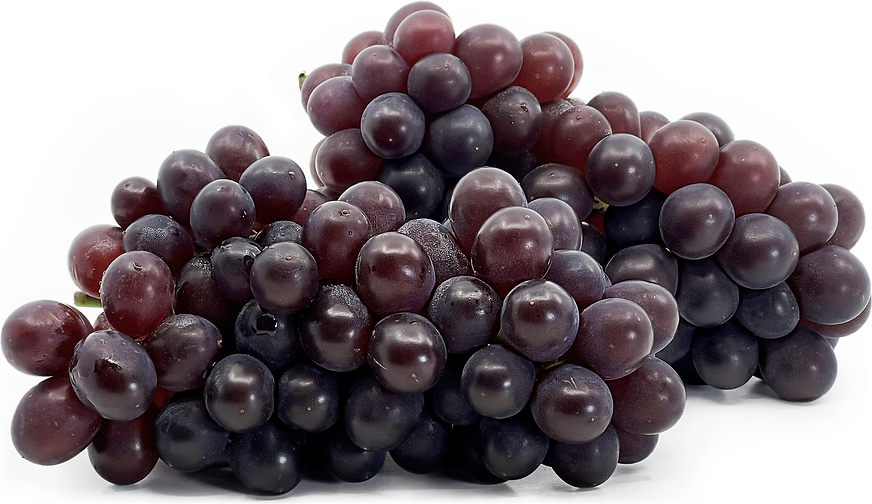


King Dela Grapes
Estimated Inventory, lb : 0
Description/Taste
King Dela grapes are a small to medium-sized varietal that grow in tightly packed, cylindrical bunches. Each grape has a round to oval appearance, weighing approximately three grams, and the skin is smooth and taut, covered in a patchy, white bloom. The skin ranges in color from red-brown to dark red-purple and has a thick, tough, and chewy nature, preventing the grapes from being punctured or easily damaged. Underneath the skin, the translucent flesh may have a green to pink hue and is aqueous, soft, tender, and seedless. King Dela grapes are aromatic, and the entire grape can be consumed, including the skin. Many consumers choose to discard the skin due to its chewy nature, and the flesh can be quickly separated from the skin if desired. King Dela grapes have a high sugar content and moderate acidity levels, contributing to the grape’s sweet and tangy, subtly tart taste combined with a distinct musky undertone.
Seasons/Availability
King Dela grapes are available in the summer through fall.
Current Facts
King Dela grapes, botanically a part of the Vitis genus, are a hybrid variety belonging to the Vitaceae family. The early-ripening grapes were developed in Japan during the 20th century and were once a popular seedless table grape highly favored for their sweet, musky flavor. King Dela grapes are a cross between the Muscat of Alexandria, a highly aromatic European white grape, and Red Pearl, a little-known black grape. The variety was created to meet the demand for a seedless table grape to supplement the surging popularity of the seeded Delaware grape in the 20th century. King Dela grapes are larger than Delaware grapes and are sometimes known as King Delaware or Dela grapes. Despite their popularity in the late 1900s, King Dela grapes eventually became overshadowed by newer seedless table grape cultivars, reducing their total production throughout Japan by almost half in the early 21st century. In the modern-day, King Dela grapes have become a specialty, premium variety localized to Japan that is often marketed in ornate packages. In fact, one of the bunches featured in the photograph above cost around twenty-five dollars in 2013.
Nutritional Value
King Dela grapes are a good source of vitamin A to maintain healthy organ functioning, vitamin K to assist in faster wound healing, and vitamin C to strengthen the immune system while reducing inflammation. The grapes also provide calcium to protect bones and teeth, potassium to balance fluid levels within the body, fiber to regulate the digestive tract, and other amounts of copper, manganese, vitamin B6, and iron.
Applications
King Dela grapes have a sweet, subtly tangy flavor well suited for raw preparations. The grapes can be consumed with or without the skin, depending on preference, and are excellent fresh out-of-hand to savor their sweet flavor and juiciness. In Japan, King Dela grapes are served without skins as the peels are considered too chewy and tough. King Dela grapes can also be sliced and tossed into green salads and fruit bowls, stirred into yogurt, displayed on charcuterie boards, or used as a fresh topping over sorbet and ice cream. In addition to culinary preparations, the sweet fruits can be frozen and mixed into beverages, skewered and placed on the rim of glasses as a festive garnish, or blended into smoothies for added flavor. Beyond fresh use, King Dela grapes are sometimes incorporated into cakes, pies, and tarts. They are also simmered into jellies or jams. King Dela grapes pair well with cheeses such as brie, cheddar, feta, and goat, other fruits including pears, strawberries, melon, and citrus, and nuts such as walnuts, pecans, hazelnuts, and almonds. Whole, unwashed King Dela grapes will keep up to one week when stored in a plastic bag in the refrigerator.
Ethnic/Cultural Info
King Dela grapes are known for their large size and seedless nature, traits that were developed using natural plant compounds known as gibberellins or gibberellic acid. Gibberellins were discovered by a Japanese plant pathologist in 1926 and were initially extracted from a fungus known as gibberella fujikuroi. This fungus was first detected on rice plants, and it was observed that the infected rice plants would grow taller and have other improved characteristics. Scientists eventually developed an extract of the compounds within the fungus that could be sprayed onto seedlings to encourage the growth of various traits, and the isolated culture was called gibberellin. In the modern-day, gibberellic acid, specifically, GA3, is used on King Dela grapes to encourage the grapes to grow to large sizes and remain seedless. GA3 is commercially produced worldwide and is purified, produced, and filtered for safe use on different grape varieties.
Geography/History
King Dela grapes were developed in Japan in the 20th century by a private grape breeder known as H. Nakamura. The triploid variety was created from a cross between Muscat of Alexandria and Red Pearl grapes and was released to commercial growers in the 1970s. In 1978, King Dela grapes were documented by the Ministry of Agriculture Forestry and Fisheries and were later officially registered as a new grape variety in 1985. After their release, King Dela grapes became a popular seedless table grape throughout Japan, achieving peak commercial production in 1997. By 2012, King Dela cultivation was cut in half due to the introduction of newer, more popular table grape varieties. Today King Dela grapes are grown on a small scale and are considered a rare, specialty variety primarily produced in the Yamanashi prefecture. When in season, King Dela grapes can be found through select farm stands, local markets, and distributors in Japan.
Recipe Ideas
Recipes that include King Dela Grapes. One
| Creative Homemaking |
|
Canning Grape Juice |
| Spiced. One Dash at a Time |
|
Blue Cheese and Roasted Grape Flatbread |
| Cooking For Keeps |
|
Roasted Grapes, Whipped Ricotta and Truffle Honey Crostini |

















